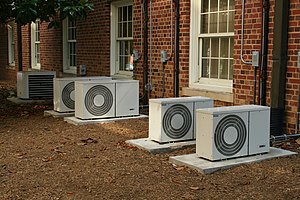
Waste heat refers to heat produced by machines, electrical equipment and industrial processes for which no useful application is found, and is regarded as a waste by-product. When produced by humans, or by human activities, it is a component of anthropogenic heat, which additionally includes unintentional heat leakage, such as from space heating. Waste heat is thought by some to contribute to the urban heat island effect. The biggest point sources of waste heat originate from machines such as electrical generators or industrial processes, such as steel or glass production. The burning of transport fuels is a major contribution to waste heat.
Conversion of energy
Machines for conversion of energy contained in fuels to mechanical work or electric energy necessarily produce large quantities of the heat as a by-product
Sources
The largest proportions of total waste heat are from power stations and vehicle engines. The largest single sources are power stations and industrial plants such as oil refineries and steelmaking plants.
Power generation
The electrical efficiency of thermal power plants, defined as the ratio between the input and output energy, is typically only 30%.
Industrial processes
Industrial processes, such as oil refining steelmaking or glassmaking are major sources of waste heat.
Electronics
Although small in terms of power, the disposal of waste heat from microchips and other electronic components, represents a significant engineering challenge. This necessitates the use of fans, heatsinks, etc. to dispose of the heat.
Biological
Animals, including humans, create heat as a result of metabolism. In warm conditions, this heat exceeds a level required for homeostasis in warm-blooded animals, and is disposed of by various thermoregulation methods such as sweating and panting. Fiala et al. modelled human thermoregulation.
Disposal
It is often difficult to find useful applications for large quantities of low temperature heat energy, so the heat is qualified as waste heat and rejected to the environment. Economically most convenient is the rejection of such heat to water from a sea, lake or river. If sufficient cooling water is not available, the plant has to be equipped with a cooling tower to reject the waste heat into the atmosphere.
Uses
Cogeneration
Waste of the by-product heat is avoided if a cogeneration system is used, also known as combined heat and power. Limitations to the use of by-product heat arise due to difficulties in heat transport and storage. Applications for waste heat include swimming pool heating, paper mills and cold chain logistics (by the use of Absorption refrigerators).
Electrification of waste heat
The organic Rankine cycle is a electricity generation process where an organic substance is used as working medium instead of water. The benefit is that this process can utilise lower temperatures for the production of electricity than the regular water steam cycle. By help of ORC-modules it is possible to turn this previously wasted energy economically into electricity.
Anthropogenic heat
Anthropogenic heat is heat generated by humans and human activity. The American Meteorological Society defines it as "Heat released to the atmosphere as a result of human activities, often involving combustion of fuels. Sources include industrial plants, space heating and cooling, human metabolism, and vehicle exhausts. In cities this source typically contributes 15–50 W m−2 to the local heat balance, and several hundred W m−2 in the center of large cities in cold climates and industrial areas."
Estimates of anthropogenic heat generation can be made by totaling all the energy used for heating and cooling, running appliances, transportation, and industrial processes, plus that directly emitted by human metabolism.
Environmental impact
AH is a small influence on rural temperatures, and becomes more significant in dense urban areas. It is one contributor to urban heat islands. Other human-caused effects (such as changes to albedo, or loss of evaporative cooling) that might contribute to urban heat islands are not considered to be anthropogenic heat by this definition.
Anthropogenic heat is a much smaller contributor to global warming than are greenhouse gases. In 2005, although anthropogenic waste heat flux was significantly high in certain urban areas (and can be high regionally. For example, waste heat flux was +0.39 and +0.68 W/m2 for the continental United States and western Europe, respectively) globally it accounted for only 1% of the energy flux created by anthropogenic greenhouse gases. Global forcing from waste heat was 0.028 W/m2 in 2005. This statistic is predicted to rise as urban areas become more widespread.
Although waste heat has been shown to have influence on regional climates, climate forcing from waste heat is not normally calculated in state-of-the-art global climate simulations.
From http://en.wikipedia.org/
Tidak ada komentar:
Posting Komentar
Catatan: Hanya anggota dari blog ini yang dapat mengirim komentar.